Pakistan
Template:Infobox State/Maintenance/TRANSCRIPTION
Template:Infobox State/Maintenance/NAME-German
Pakistan (Urdu پاکستان [![]()
![]() paːkɪst̪aːn̪], officially: Islamic Republic of Pakistan) is a country in South Asia. It borders Iran to the southwest, Afghanistan to the west, China to the north, and India to the east. In the south, Pakistan shares the coast of the Arabian Sea, a tributary of the Indian Ocean.
paːkɪst̪aːn̪], officially: Islamic Republic of Pakistan) is a country in South Asia. It borders Iran to the southwest, Afghanistan to the west, China to the north, and India to the east. In the south, Pakistan shares the coast of the Arabian Sea, a tributary of the Indian Ocean.
The state of Pakistan was created in 1947 from the Muslim-majority parts of British India, while the Hindu-majority or other areas and most of predominantly Muslim Kashmir were absorbed into what is now India. In 1956, Pakistan proclaimed itself the world's first Islamic Republic. The former part of East Pakistan has been independent as Bangladesh since the Bangladesh War of 1971. Pakistan's recent history is dominated by its conflict with India over the Kashmir region (see Kashmir conflict).
Today, Pakistan is plagued by chronic instability. Ethnic-religious conflicts, corruption, terrorism and political dysfunctionality are problems in the country, even if slight progress has been made in recent years. The country is one of the poorest and least developed states in Asia. At the same time, it has nuclear weapons and possesses the sixth largest army in the world. Pakistan produced the twenty-fifth largest economic output in 2016 and has a growing middle class.
Geography
Pakistan stretches between the 24th and 37th parallel north and between the 61st and 77th longitude east over an area of 796,095 square kilometres, making it the ninth largest state in Asia. Including Asad Kashmir and the Gilgit-Baltistans (former Northern Territories), Pakistan covers 880,254 square kilometers, about twice as much as Germany and Austria combined. The north-south extent of the country is about 1500 kilometers. It borders four independent states: Iran (978 kilometers) to the southwest, Afghanistan (2643 kilometers) to the west and north, China (523 kilometers) to the northeast, and India (2912 kilometers) to the east. To the south, Pakistan has a 1046-kilometer coastline on the Arabian Sea.
Pakistan has a national border of 7056 kilometers in total length.
Nature area
· 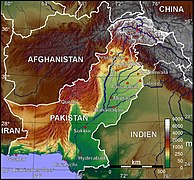
Topographic map of Pakistan
· 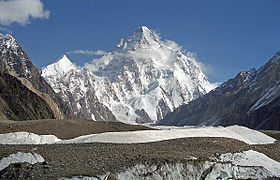
The K2 (8611 meters) is the highest mountain of Pakistan
· 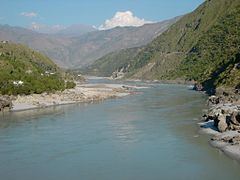
Valley of the Indus in the Karakorum
· 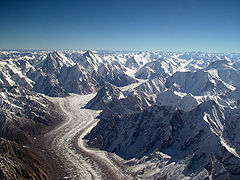
The 62-kilometre-long Baltoro Glacier in northern Pakistan is one of the longest non-polar glaciers
In the far north of Pakistan, the Hindu Kush, the Karakoram and the Himalayas, the three highest mountain ranges on earth, meet and shield the country from Central Asia. The Hindu Kush stretches from the Afghan border in the west to the upper reaches of the Indus in the east and reaches an altitude of almost 7700 metres with the Tirich Mir. In the heavily glaciated Karakoram, north of the Indus, lies K2, at 8611 metres the highest elevation in Pakistan and the second highest peak on earth. South of the narrow high valley of the upper Indus, the country has a small portion of the Himalayas with NangaParbat (8125 meters) as the northwestern "cornerstone" of the range. Five of the world's 14 eight-thousanders lie in Pakistani-controlled territory.
See also: List of the highest mountains or elevations in Pakistan
The Indus plain, which adjoins the high mountain region to the south, occupies more than one-third of the country's area. After leaving the high mountain region of the extreme north and turning south, the Indus first crosses the Potwar plateau between the cities of Peshawar and Faisalabad, which rises once more to the south to form the Salt Range, over 1100 metres high, and then drops into the lowlands of the Punjab. Only the western part of the "five-stream country" Punjab with the rivers Satluj, Chanab, Jhelam and Ravi belongs to the catchment area of the Indus in Pakistan. The fifth major river, the Beas, already flows into the Satluj on Indian territory. Satluj and Chenab join west of Bahawalpur to form the Panjnad, which flows into the Indus shortly afterwards. Low elevations called doab separate the shallow alluvial valleys of the Punjabi rivers. South of the mouth of the Panjnad, the strongly meandering Indus crosses a broad alluvial plain in south Punjab and the Sindh region. Finally, it flows into the Arabian Sea in a delta of about 8000 square kilometers.
In the west of Pakistan, the chains of the Suleiman and Brahui Mountains, each up to 3,500 metres high, and the Kirthari Mountains, which reach maximum heights of around 2,200 metres, shield the industrial lowlands from the average 600-metre-high, drainage-free highlands of Balochistan on the border with Iran. Baluchistan is also crossed by several mountain ranges, some of which rise up to 3000 meters. The southern end of Baluchistan is formed by the Makran Mountains, which drop steeply to the Makran Coast on the Arabian Sea.
To the east, the Thar Desert, south of the Punjab, borders the Indus River plain. In the extreme southeast, Pakistan shares the salt marsh of the Rann of Kachchh.
Climate
| Climate diagrams | ||
Pakistan has a predominantly arid subtropical continental climate with considerable local and seasonal variation.
In the lowlands, the average temperatures of the coldest month January vary between 12 degrees Celsius in the north and 17 °C in the south, only on the coast the monthly average is around 20 °C even in winter. In the summer months from May to September it gets unbearably hot everywhere in the country, with the exception of the higher altitudes. The average temperatures are then usually above 30 °C. In the inland areas, temperatures can even rise to a few degrees Celsius. In the inland areas, maximum temperatures of up to 50 °C can occur. The distribution of precipitation is also highly uneven. In general, it decreases from north to south. Only the Himalayan foothills in the extreme north of the Punjab receive abundant rainfall, with some areas receiving over 1000 mm per year. Lahore receives only about 500 mm, southern Punjab and Sindh less than 200 mm. Rainfall occurs almost exclusively during the short southwest monsoon in July and August, the rest of the year is dry.
Extreme drought also prevails in Balochistan. In the western highlands, the annual rainfall is not even 100 mm. In winter there are often night frosts, the average temperatures of January are only around 10 °C. In summer, however, similar high values are reached as in the Indus plains. Only in the higher altitudes it is correspondingly cooler, in the peripheral mountains between the plateau of Baluchistan and the Indus lowlands also somewhat more humid with 200 to 300 mm of rain per year. Balochistan receives most of its scanty rainfall in winter. The summer monsoon brings minimal rain to eastern Balochistan and none at all to the west of the region.
The high valleys in the far north of Pakistan are climatically very different from other parts of the country. Sub-zero temperatures are not uncommon in winter, even during the day. Although the summers are warm, the extreme heat of the lowland climates is missing. The annual rainfall is highest in the Himalayas, sometimes exceeding 1500 mm, and decreases towards the north and west.
Vegetation
In large parts of Pakistan, the desert-like climate allows only extremely sparse vegetation. Forests originally existed in the form of gallery forests along the Indus and its permanently water-bearing tributaries, and in the form of coniferous forests in the high mountains of the north. While the latter have been preserved, at least in part, the riverine forests are now almost completely destroyed. In the lowlands, high population density and intensive agricultural use have led to the formation of a cultural landscape shaped by man: Only just under 4 % of Pakistan's land area is still covered with forest today.
Large, contiguous forest stands can still be found in the high mountain zone in northern Pakistan. Dense coniferous forests with various species of pine (Pinus), Himalayan cedar (Cedrus deodara) and Himalayan spruce (Picea smithiana), occasionally also mixed forests with oak (Quercus), extend between 1000 and 3000 metres above sea level. In the lower-precipitation mountainous areas of the Hindu Kush in the extreme northwest and the Karakoram in the extreme north and northeast, dry mountain forests with dry pines (Pinus gerardiana) and holm oaks (Quercus ilex) predominate. Just above the tree line, rhododendrons and other dwarf shrubs thrive, above which there are only alpine mats. The snow line is above 4500 meters, in the Karakorum even between 5400 and 5800 meters.
Dry deciduous forests with olive trees (Olea) and acacias (Acacia) grow in the peripheral mountains to the south of the Hindu Kush as well as in the Sulaiman and Brahui mountains. At lower altitudes, these are often severely degraded by overgrazing.
Open thorn forests used to be the typical vegetation form of the Indus lowlands. Today, however, this type of forest has been largely repressed by the extensive use of the plains as farmland and is confined to small, scattered forest islands. Characteristic plants are low tree species well adapted to aridity, such as the kheji tree (Prosopis cineraria). The undergrowth consists mainly of thorn bushes. In the Indus estuary delta, saltwater-resistant Avicennia marina trees form mangrove forests.
In Baluchistan, in the unirrigated parts of Sindh and in the southeast and west of Punjab, tree-free semi-deserts and deserts extend. The plant cover there consists of particularly persistent hard grasses and briars. Only in oases also low tree species occur.
Wildlife
Pakistan is home to around 190 different species of mammals. However, many large mammals were wiped out in the 19th and 20th centuries through hunting and the destruction of their habitats, including the Indian elephant, the Royal Bengal tiger, the Asiatic lion and the cheetah. Only a few hundred leopards and snow leopards remain in the mountains of northern Pakistan, and their survival is severely threatened, as well as ibex, screw goats, steppe sheep, giant wild sheep and lynx. The majestic Marco Polo giant wild sheep is protected along with Siberian ibex and snow leopards in Khunjerab National Park, while screw goats are found in Chitral Gol National Park. The most common cat species is the reed cat, native to the flood plains. The caracal or desert lynx, on the other hand, prefers open steppe and semi-desert landscapes. Two species of bear occur in Pakistan: the ruffed bear in the Himalayas, Hindu Kush and mountains of Baluchistan, and the brown bear in the Karakoram. Both species are rare. Also threatened is the hog deer. In contrast, wild boar are still very numerous, as are many rodents. Indian gazelles still live in the semi-desert areas, and deer goat antelopes are partly being reintroduced in national parks such as Kirthar National Park. Originally, the Indus Valley was also home to the armoured rhinoceros. These animals have now been reintroduced to a large enclosure in the Lal Suhanra National Park, along with deer goats, Nile antelopes and hog deer. A subspecies of the endangered Ganges dolphin lives in the Indus.
The bird life of Pakistan is very diverse with almost 670 native and migratory bird species. Many large birds of prey such as eagles, buzzards, hawks and vultures have become rare, but even the once typical blue peacock is only found in small remnants. Sparrows, swallows, fowl birds (including Pakistan's national bird, the chukar), parrots, lapwings, woodpeckers, pigeons and corvids are widespread. Waterfowl such as ducks, herons and flamingos are also abundant, pelicans are rarer.
Among the more than 200 native reptile species are more than 110 species of lizards, nearly 80 species of snakes and 15 species of turtles. In addition, the swamp crocodile and the Ganges gavial live in Pakistan. Amphibians are represented in Pakistan with 16 species.
The largest national park in the country is Hingol National Park, which still has stable populations of wild goats and wild sheep, as well as some swamp crocodiles. Fish species are estimated at 500 marine and 125 freshwater, insects and invertebrates at 20,000.
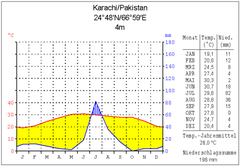

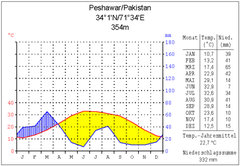
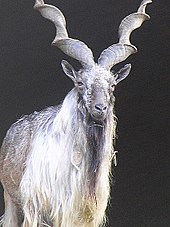
The screw goat lives in the mountains of Pakistan
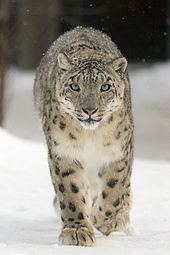
Snow leopards are threatened with extinction in Pakistan
Education
Although progress has been made in building the education system since independence, Pakistan's illiteracy rate remained one of the highest in Asia at about 42 percent during the 2015-2016 survey period. For males, it is much lower at 30 percent compared to 52 percent for females. There has been little progress in this regard from 2004 to 2015 (unlike, for example, neighboring India). Yet, in 2017, the Pakistani government spent only about 2.2 percent of GDP on education - less than any other country in South Asia. Also, to date, there is no universal compulsory schooling or education. Only in the province of Punjab has attendance at primary school been compulsory by law since 1994, and free since 2014. Since 2010, the constitution has mentioned the goal of free and compulsory education. According to a 2014 UNESCO report, 5.5 million children in Pakistan were not in school; the second highest number in the world (after Nigeria). According to figures from the Ministry of Education at the beginning of 2017, 22.6 million children in Pakistan were not attending school, and in the same year Human Rights Watch lamented the devastating impact on education of the more than 800 attacks on schools between 2007 and 2015. Their report pointed to militant groups that were not sufficiently or even at all prosecuted by the authorities.
Education system
The state education system is three-tiered. The five-year primary school, which children are allowed to attend from the age of five, is followed by the three-year secondary school. Secondary education proper comprises two years of education at a high school, which is completed with an examination, and subsequently at a higher secondary school, which also lasts two years. Successful completion of Higher Secondary School entitles the student to attend a state university. There are over 110 recognized public and private universities in Pakistan.
In addition to the state schools, thousands of madaris or madrasas are an important pillar of the education system. As a rule, they also offer free basic education to children from poor families who would not be able to attend a state educational institution. Not infrequently they also provide humanitarian aid. However, they are not subject to any state control, so that religious extremists also use medreses to spread extremist ideas.
According to the Pakistani constitution, children should be guaranteed free basic education. The reality, however, is different. UNESCO called the literacy rate in Pakistan "disturbingly low". According to UNESCO statistics, 56.4% of the population could read in 2015 (69.4% of men and 42.7% of women). This put Pakistan well below its neighbours Iran, India and the People's Republic of China, but ahead of Afghanistan. The best reading literacy score in 2013/14 was in Punjab (61%), while the worst scores were in Khyber Pakhtunkhwa (53%) and Balochistan (43%).
Librarianship
Over 6000 libraries are available in academic, private sector and religious institutions. The public library system is severely underdeveloped. The almost 300 public libraries are located in larger cities. In the 1980s, over 4000 box libraries were established in rural areas, and little is known about their current state. Since 1998, national education policy has called for the establishment of libraries in rural areas - but so far without consequences.
According to the PTCL (Pakistan Telecommunication Company Limited), Internet access should be possible for 95 percent of the population. A relatively large number of Internet cafes makes this figure likely to be correct. A very small number of Cyber Community Centers established with international assistance provide quality Internet information access in the country and offer PC and Internet courses.
A postgraduate diploma in Library and Information Science can be obtained at six universities.
Science
In 1979, Pakistani physicist Abdus Salam (1926-1996) received the Nobel Prize in Physics and the Albert Einstein Medal from UNESCO for his contribution to the theory of unified weak and electromagnetic interactions between elementary particles. Abdus Salam was the first Pakistani and the first Muslim to win the Nobel Prize in Physics. Abdus Salam was a follower of the Ahmadiyya Muslim Jamaat.
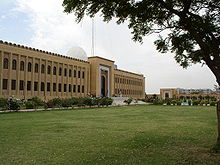
The National University of Computer and Emerging Sciences in Karachi .

The University of the Punjab in Lahore is Pakistan's largest and oldest university (founded in 1882).

UIS reading ability of adult population of Pakistan 1950-2015.
Questions and Answers
Q: What is the official name of Pakistan?
A: The official name of Pakistan is the Islamic Republic of Pakistan.
Q: How many people live in Pakistan?
A: As of 2020, there are 207.77 million people living in Pakistan.
Q: What is the total land area of Pakistan?
A: The total land area of Pakistan is 880,940 km2 (340,130 sq mi), including the Pakistani controlled territories of Azad Kashmir and Gilgit Baltistan.
Q: Where is the capital city located in Pakistan?
A: The capital city of Pakistan is Islamabad. Before 1960 it was Karachi, which is now the country's largest city.
Q: What does Pākistān mean in Persian and Urdu?
A: In Persian and Urdu, Pākistān means Land of the Pure.
Q: Which countries border with Pakistan?
A: Countries that border withPakistan include India, Iran, Afghanistan, and China.
Q: What rank does Pakistans army have globally?
A:Pakistan has the seventh largest army in the world.
Search within the encyclopedia